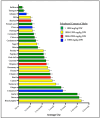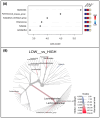Relationships between Habitual Polyphenol Consumption and Gut Microbiota in the INCLD Health Cohort
- PMID: 38542685
- PMCID: PMC10974568
- DOI: 10.3390/nu16060773
Relationships between Habitual Polyphenol Consumption and Gut Microbiota in the INCLD Health Cohort
Abstract
While polyphenol consumption is often associated with an increased abundance of beneficial microbes and decreased opportunistic pathogens, these relationships are not completely described for polyphenols consumed via habitual diet, including culinary herb and spice consumption. This analysis of the International Cohort on Lifestyle Determinants of Health (INCLD Health) cohort uses a dietary questionnaire and 16s microbiome data to examine relationships between habitual polyphenol consumption and gut microbiota in healthy adults (n = 96). In this exploratory analysis, microbial taxa, but not diversity measures, differed by levels of dietary polyphenol consumption. Taxa identified as exploratory biomarkers of daily polyphenol consumption (mg/day) included Lactobacillus, Bacteroides, Enterococcus, Eubacterium ventriosum group, Ruminococcus torques group, and Sutterella. Taxa identified as exploratory biomarkers of the frequency of polyphenol-weighted herb and spice use included Lachnospiraceae UCG-001, Lachnospiraceae UCG-004, Methanobrevibacter, Lachnoclostridium, and Lachnotalea. Several of the differentiating taxa carry out activities important for human health, although out of these taxa, those with previously described pro-inflammatory qualities in certain contexts displayed inverse relationships with polyphenol consumption. Our results suggest that higher quantities of habitual polyphenol consumption may support an intestinal environment where opportunistic and pro-inflammatory bacteria are represented in a lower relative abundance compared to those with less potentially virulent qualities.
Keywords: culinary herbs and spices; microbiome; phytochemicals; polyphenols.
Conflict of interest statement
The authors declare no conflicts of interest. The funders had no role in the design of the study; in the collection, analyses, or interpretation of data; in the writing of the manuscript; or in the decision to publish the results.
Figures







Similar articles
-
Associations between Frequency of Culinary Herb Use and Gut Microbiota.Nutrients. 2022 May 9;14(9):1981. doi: 10.3390/nu14091981. Nutrients. 2022. PMID: 35565947 Free PMC article.
-
Lythrum salicaria L. herb and gut microbiota of healthy post-weaning piglets. Focus on prebiotic properties and formation of postbiotic metabolites in ex vivo cultures.J Ethnopharmacol. 2020 Oct 28;261:113073. doi: 10.1016/j.jep.2020.113073. Epub 2020 Jul 14. J Ethnopharmacol. 2020. PMID: 32673710
-
Whole Blueberry and Isolated Polyphenol-Rich Fractions Modulate Specific Gut Microbes in an In Vitro Colon Model and in a Pilot Study in Human Consumers.Nutrients. 2020 Sep 12;12(9):2800. doi: 10.3390/nu12092800. Nutrients. 2020. PMID: 32932733 Free PMC article. Clinical Trial.
-
Roles of the Polyphenol-Gut Microbiota Interaction in Alleviating Colitis and Preventing Colitis-Associated Colorectal Cancer.Adv Nutr. 2021 Mar 31;12(2):546-565. doi: 10.1093/advances/nmaa104. Adv Nutr. 2021. PMID: 32905583 Free PMC article. Review.
-
Dietary polyphenol impact on gut health and microbiota.Crit Rev Food Sci Nutr. 2021;61(4):690-711. doi: 10.1080/10408398.2020.1744512. Epub 2020 Mar 25. Crit Rev Food Sci Nutr. 2021. PMID: 32208932 Review.
Cited by
-
Dietary Polyphenols, Plant Metabolites, and Allergic Disorders: A Comprehensive Review.Pharmaceuticals (Basel). 2024 May 22;17(6):670. doi: 10.3390/ph17060670. Pharmaceuticals (Basel). 2024. PMID: 38931338 Free PMC article. Review.
-
Perspective on the Coevolutionary Role of Host and Gut Microbiota in Polyphenol Health Effects: Metabotypes and Precision Health.Mol Nutr Food Res. 2024 Nov;68(22):e2400526. doi: 10.1002/mnfr.202400526. Epub 2024 Nov 13. Mol Nutr Food Res. 2024. PMID: 39538982 Free PMC article. Review.
-
The Role of Microbial Metabolites in the Progression of Neurodegenerative Diseases-Therapeutic Approaches: A Comprehensive Review.Int J Mol Sci. 2024 Sep 18;25(18):10041. doi: 10.3390/ijms251810041. Int J Mol Sci. 2024. PMID: 39337526 Free PMC article. Review.
-
Mutual Interactions of Silymarin and Colon Microbiota in Healthy Young and Healthy Elder Subjects.Mol Nutr Food Res. 2024 Nov;68(22):e2400500. doi: 10.1002/mnfr.202400500. Epub 2024 Oct 30. Mol Nutr Food Res. 2024. PMID: 39473280 Free PMC article.
-
(Poly)phenol-gut microbiota interactions and their impact on human health.Curr Opin Clin Nutr Metab Care. 2025 Jul 1;28(4):316-322. doi: 10.1097/MCO.0000000000001132. Epub 2025 Apr 28. Curr Opin Clin Nutr Metab Care. 2025. PMID: 40293967 Free PMC article. Review.

